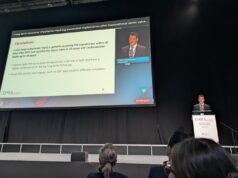
A population-based cohort study of patients treated in the Austrian healthcare system has found that transcatheter aortic valve implantation (TAVI) is associated with a significantly increased rate of all-cause mortality than surgical aortic valve replacement (SAVR) in patients over the age of 65 treated for severe aortic stenosis.
These were the findings of the AUTHEARTVISIT study which looked at mid-term survival and outcomes among more than 18,000 patients selected for either SAVR (62.2%) or TAVI (37.8%) within the Austrian healthcare system between 2010 and 2020.
Findings of the study were presented by Johann Auer (St Joseph Hospital, Braunau, Austria) during a late breaking science session at the 2023 European Association of Cardio-Thoracic Surgery (EACTS) annual meeting (4–7 October, Vienna, Austria).
“In general, surgical aortic valve replacement is considered the gold standard of aortic valve replacement because it usually provides a long-lasting and more durable solution compared with TAVI,” Auer commented in the introduction to his presentation.
He noted that some clinical trials have demonstrated equivalent or even superior outcomes with TAVI compared to SAVR, particularly in elderly patients across a variety of risk categories. This has in turn led to guideline changes and has subsequently seen the number of TAVI procedures surpassing SAVR in recent years.
“The objective of our study was to compare overall survival in transcatheter aortic valve replacement and surgically implanted bioprosthesis in patients with severe symptomatic aortic stenosis and to compare secondary outcomes such as reoperation, stroke, myocardial infarction, and incident heart failure between TAVI and SAVR,” Auer explained.
The primary outcome of the study was overall survival, while secondary outcomes included reoperation, stroke, myocardial infarction and incidence of heart failure.
With a median follow-up period of four years, Auer reported that the overall rate of survival was “significantly worse” in patients selected for TAVI than, both in the overall cohort of patients, as well as a propensity score matched analysis.
The risk of all-cause mortality was higher with TAVI compared with SAVR: hazard ratio (HR) 1.552, 95% confidence interval (CI: 1.469–1.640, p<0.001), with a propensity score–matched HR of 1.510, (1.403–1.625, p<0.001). Estimated median survival was 8.8 years (95% CI: 8.6–9.1) with SAVR compared to five years (4.9–5.2) with TAVI. Estimated five-year overall survival probability was 0.664 (0.664–0.686) with SAVR vs. 0.409 (0.378–0.444) with TAVI, and 0.690 (0.674–0.707) and 0.560 (0.540–0.582) with propensity score matching, respectively.
The investigators also performed a time-dependent analysis, and Auer reported that in the first year after their procedure, there was no difference in mortality between the two groups. “But, up to two years and beyond,” he noted, “there was a survival advantage for surgical bioprosthetic aortic valve replacement”.
Pacemaker implantation, as would be expected in a study comparing SAVR with TAVI, was higher among the TAVI patients (11.2% vs. 4.5% in the SAVR arm) and was associated with higher mortality in this patient group according to Auer. The risk of reoperation, development of heart failure, myocardial infarction and stroke was not significantly associated with intervention type, Auer reported.
Auer did note several limitations associated with the analysis. “Choice of procedure type is not the only factor of survival and several other positive factors which include age, sex previous heart failure, diabetes and chronic kidney disease were also significantly associated with survival in the overall and in the propensity matched cohorts,” he relayed. Furthermore, he commented, in any observational research, “even with a very large centre size and long-term follow up, unmeasured confounding could persist”. The data did not include all parameters for accurate calculation of surgical risk and frailty scores, Auer added.













